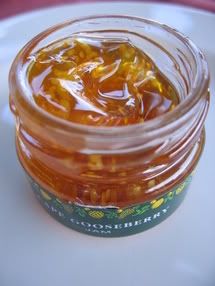Apricot and Soy Salmon

The Yanks have their molasses and maple syrup; the Brits have their treacle and golden syrup; the Thais have their palm sugar. And the South Africans have apricot jam.
Apricot jam gives many traditional dishes a sweet - but not sugary - note, which is both rich and tangy. A spoonful of the lovely stuff is put in many of the country’s favourite dishes. It stars in some Afrikaner desserts, such as malva pudding, a sticky, moist dessert which is cooked in a cream custard sauce. It is used extensively in Cape Malay cuisine, in everything from ingelegde vis (pickled fish) to sosaties (curried kebabs) to bobotie (curried mince baked with a creamy topping). No South African pantry is without it, and it can be found in any shop worth its salt (or perhaps we should say, worth its apricot jam).
Tonight I used it in one of my mother’s favourite ways: mixed with soy sauce and smeared on fish. The slippery, salty soy contrasts delightfully with the sweet, jammy apricot, creating an instant sweet-and-sour sauce. I jazzed it up a bit with the addition of a panko crust, so you bite through a crunchy, garlicky exterior, hit a sweet-sour, jammy layer, before sinking your teeth into the moist, meaty salmon.
Apricot and Soy Salmon
For a filet of boned salmon large enough to feed two people, you will need:
Several tablespoonfuls of smooth apricot jam
Soy sauce
1 clove of garlic, chopped
A small handful of panko, or fine, crisp breadcrumbs
1 TBS Slivered or finely chopped almonds, and/or sesame seeds
A teaspoon of lime zest
Lime juice
Salt and pepper
Freshly chopped dhania (cilantro/coriander leaves)
Half a tablespoon of butter, chopped into little pieces
Preheat your oven to 400F/200C, and lightly oil a baking sheet.
For the apricot-soya glaze:
Take several tablespoonfuls of apricot jam. If it’s quite thick, microwave for twenty-odd seconds to loosen its consistency. Add a splash of soy sauce, and stir until the mixture is smooth.
Pat dry your piece of salmon, and place skin-down on the oiled baking sheet. Spread the soy-apricot mixture all over it (if the salmon’s damp, the glaze won’t stick!).
For the panko crust:
Toast the almonds/sesame seeds in a frying pan. In a bowl, combine them with the panko or bread crumbs. Add the lime zest, chopped garlic, and some salt and pepper. Mix, and then spread over the glaze, on top of the salmon. The glaze should help the crust stick to the fish. Dot the crust all over with your little pieces of butter.
Admire how professional it looks, and then place in the oven. I turn the heat down to 350F/180C after ten minutes. Depending on the fierceness of your oven, and on the thickness and type of your salmon (king salmon dries out quicker than Atlantic salmon, for example), it should be done five to ten minutes later. If you’re nervous about undercooking it, gently try to break apart the flesh in the thickest part of the salmon. It should shred easily, but still look moist. If it feels like steak, or the middle looks glassy, you need to give it a bit more time. Remember, it will keep on cooking a bit after you take it out of the oven.
Squeeze some lime juice over the crunchy, golden salmon, sprinkle liberally with the chopped dhania, and serve immediately.
Categories: Ingredients, Recipes


0 Comments:
Post a Comment
<< Home